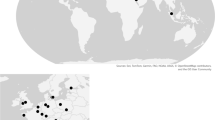Abstract
This study used statistical simulations to investigate the performance of the population bioequivalence test applied to image-based particle size measurements (such as morphologically directed Raman spectroscopy) and methods for designing in vitro bioequivalence trials using prior information. Simulations of in vitro population bioequivalence trials were conducted across a range of representative D50 (number-weighted median particle diameter from a log-normal particle size distribution) and span (which is defined as \( \frac{D_{90}-{D}_{10}}{D_{50}} \) where D90 and D10 are the number-weighted 90th and 10th percentiles in particle diameters sampled from a log-normal particle size distribution) values respectively. The performance of the population bioequivalence test in the simulations was driven by an interplay between overall test variability and the widening or narrowing of the bioequivalence region due to variance terms in the test statistic definition. These findings were dependent upon differences in the variability of D50 and span and may generalise to a wider range of in vitro metrics. Trial design optimisation using power and assurance approaches followed patterns consistent with these findings. As more novel scientific methods are applied to the development of complex generic drug products, the procedures outlined in this study may be used at the inception stage of future in vitro bioequivalence trials to reduce the risk of conducting costly trials with low probabilities of success.







Similar content being viewed by others
References
21 CFR 320.1(e).
Lee SL, Adams WP, Li BV, Conner DP, Chowdhury BA, Yu LX. In vitro considerations to support bioequivalence of locally acting drugs in dry powder inhalers for lung diseases. AAPS J. 2009;11(3):414–23.
Lu Y, Chow SC, Zhu S. In vivo and in vitro bioequivalence testing. J Bioequivalence Bioavailab. 2014;6(2):67–74.
Gottlieb S. Reducing the hurdles for complex generic drug development [Internet]. 2017 [cited 2020 Jan 7]. Available from: https://www.fda.gov/news-events/fda-voices-perspectives-fda-leadership-and-experts/reducing-hurdles-complex-generic-drug-development. Accessed 7 Jan 2020.
Liu Q, Absar M, Saluja B, Guo C, Chowdhury B, Lionberger R, et al. Scientific considerations for the review and approval of first generic mometasone furoate nasal suspension spray in the United States from the bioequivalence perspective. AAPS J. 2019;21(2):1–6.
FDA. Statistical approaches to establishing bioequivalence [Internet]. 2001. Available from: https://www.fda.gov/regulatory-information/search-fda-guidance-documents/statistical-approaches-establishing-bioequivalence. Accessed 7 Jan 2020.
Sandell D. A real case comparison of average and population bioequivalence for evaluation of APSD data. In: IPAC-RS/UF Orlando Inhalation Conference [Internet]. 2014. Available from: https://ipacrs.org/assets/uploads/outputs/08-Day_2_OIC_2014_Sandell.pdf. Accessed 7 Jan 2020.
Chen S, Morgan B, Beresford H, Burmeister Getz E, Christopher D, Långström G, et al. Performance of the population bioequivalence (PBE) statistical test with impactor sized mass data. AAPS PharmSciTech. 2019;20(7).
Grmaš J, Lužar-Stiffler V, Dreu R, Injac R. A novel simulation-based approach for comparing the population against average bioequivalence statistical test for the evaluation of nasal spray products on spray pattern and droplet size distribution parameters. AAPS PharmSciTech. 2019;20(1):1–14.
FDA. Bioavailability and bioequivalence studies for nasal aerosols and nasal sprays for local action [Internet]. Available from: https://www.fda.gov/regulatory-information/search-fda-guidance-documents/bioavailability-and-bioequivalence-studies-nasal-aerosols-and-nasal-sprays-local-action. Accessed 7 Jan 2020.
FDA. Draft guidance on beclomethasone dipropionate [Internet]. 2019. Available from: https://www.accessdata.fda.gov/drugsatfda_docs/psg/BeclomethasondipropionateInhalationAerosolMeteredNDA207921PSGPageRCMay2019.pdf. Accessed 7 Jan 2020.
FDA. Draft guidance on fluticasone propionate [Internet]. Available from: https://www.accessdata.fda.gov/drugsatfda_docs/psg/PSG_020121.pdf. Accessed 7 Jan 2020.
Chow SC, Shao J, Wang H. In vitro bioequivalence testing. Stat Med. 2003;22(1):55–68.
Morgan B, Strickland H. Performance properties of the population bioequivalence approach for in vitro delivered dose for orally inhaled respiratory products. AAPS J. 2014;16(1):89–100.
Morgan B, Chen S, Christopher D, Långström G, Wiggenhorn C, Burmeister Getz E, et al. Performance of the population bioequivalence (PBE) statistical test using an IPAC-RS database of delivered dose from metered dose inhalers. AAPS PharmSciTech. 2018;19(3):1410–25.
FDA. Draft guidance on budesonide [Internet]. Available from: https://www.accessdata.fda.gov/drugsatfda_docs/psg/Budesonide_Inhalation_Sus_20929_RC_09-12.pdf. Accessed 7 Jan 2020.
Hu M, Jiang X, Absar M, Choi S, Kozak D, Shen M, et al. Equivalence testing of complex particle size distribution profiles based on earth mover’s distance. AAPS J. 2018;20(3):1–10.
FDA. Draft guidance on azelastine hydrochloride; fluticasone propionate [Internet]. 2020. Available from: https://www.accessdata.fda.gov/drugsatfda_docs/psg/PSG_202236.PDF. Accessed 7 Jan 2020.
Ganley WJ, Shur J, Price R. Model informed design of in vitro bioequivalence trials. Respir Drug Deliv 2020. 2020;2:385–8.
Price RM, Bonett DG. Estimating the variance of the sample median. J Stat Comput Simul. 2001;68(3):295–305.
Carpenter B, Gelman A, Hoffman MD, Lee D, Goodrich B, Betancourt M, et al. Stan: a probabilistic programming language. J Stat Softw. 2017;76(1).
Stan Development Team. RStan: the R interface to Stan [Internet]. 2020. Available from: http://mc-stan.org/. Accessed 1 Feb 2020.
McElreath R. rethinking: statistical rethinking book package. 2020.
R Core Team. R: a language and environment for statistical computing [Internet]. Vienna, Austria; 2020. Available from: https://www.r-project.org/. Accessed 1 Feb 2020.
Wickham H. ggplot2: elegant graphics for data analysis [Internet]. Springer-Verlag New York; 2016. Available from: https://ggplot2.tidyverse.org. Accessed 1 Feb 2020.
Campitelli E. metR: tools for easier analysis of meteorological fields [Internet]. 2020. Available from: https://cran.r-project.org/package=metR. Accessed 1 Feb 2020.
The authors thank reviewer 2 for suggestions on how to better relate this section to current guidance.
O’Hagan A, Stevens JW, Campbell MJ. Assurance in clinical trial design. Pharm Stat. 2005;4(3):187–201.
Chen DG (Din), Ho S. From statistical power to statistical assurance: it’s time for a paradigm change in clinical trial design. Commun Stat Simul Comput 2017;46(10):7957–7971.
Carroll KJ. Decision making from phase II to phase III and the probability of success: reassured by assurance? J Biopharm Stat. 2013;23(5):1188–200.
Author information
Authors and Affiliations
Corresponding author
Additional information
Publisher’s Note
Springer Nature remains neutral with regard to jurisdictional claims in published maps and institutional affiliations.
Electronic Supplementary Material
ESM 1
(DOCX 3917 kb)
Rights and permissions
About this article
Cite this article
Ganley, W.J., Shur, J. & Price, R. Simulation Informed Design and Performance of In Vitro Bioequivalence Trials for Particle Size Distributions. AAPS J 22, 139 (2020). https://doi.org/10.1208/s12248-020-00520-6
Received:
Accepted:
Published:
DOI: https://doi.org/10.1208/s12248-020-00520-6




